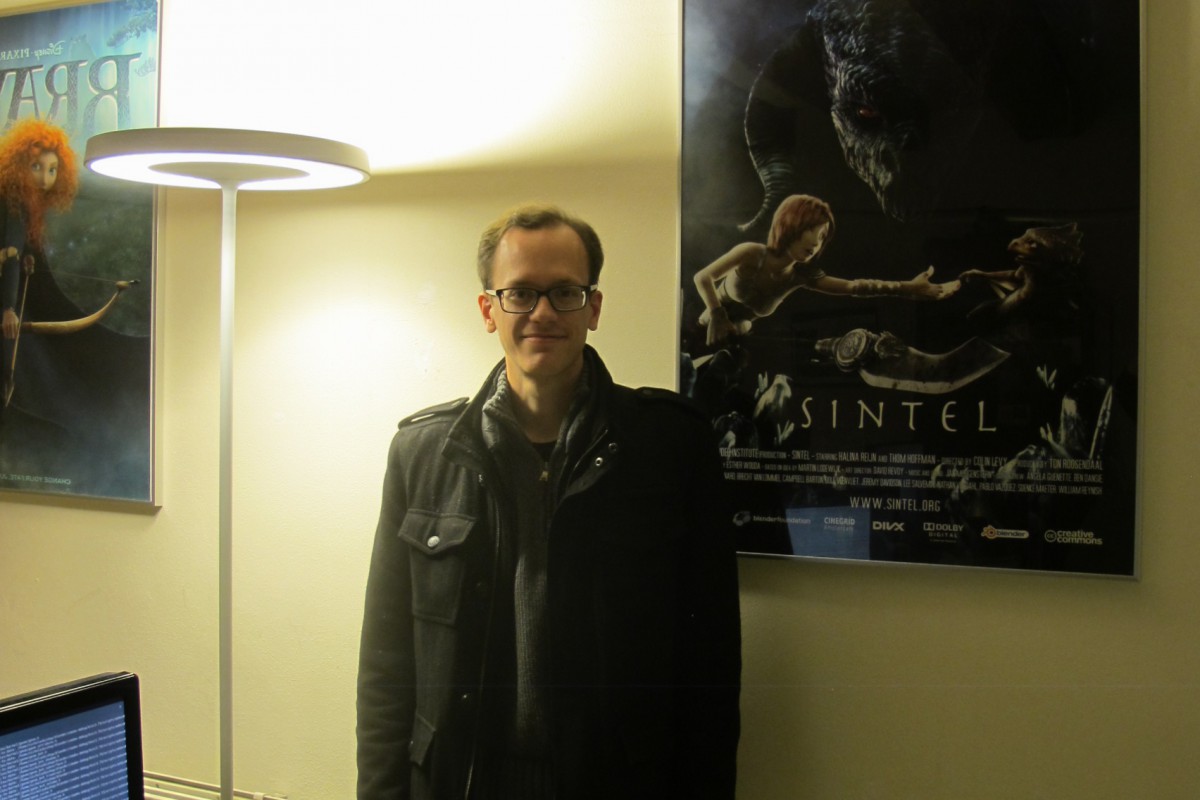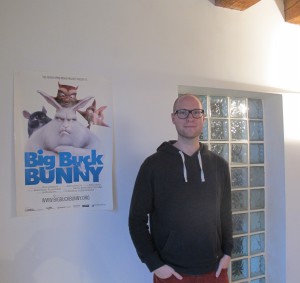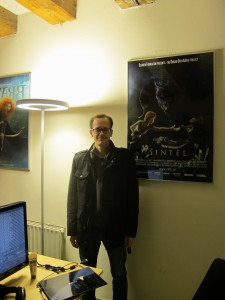
Today is the first day back in the studio for most members of Team Gooseberry — including two new faces (for this project)!
 If you’ve been following Blender for a while, you’re probably already very familiar with our first “new” face: Andy Goralczyk. He’s been working with Blender for about 15 years now (since he was in high school), has attended every Blender Conference, and has worked on previous open projects Elephants Dream (the first), Big Buck Bunny, Tears of Steel, and Caminandes 2. The studio has been eagerly awaiting his arrival…but first he had the little matter of wrapping up his graduate degree in Media Arts at the College of Arts & Design in Karlsruhe, Germany. Luckily for us, that was completed in November with the three-day exhibition of his (Blender-designed) 3D-printed robotic garden. (Which some of you probably saw him discuss at the Blender Conference.)
If you’ve been following Blender for a while, you’re probably already very familiar with our first “new” face: Andy Goralczyk. He’s been working with Blender for about 15 years now (since he was in high school), has attended every Blender Conference, and has worked on previous open projects Elephants Dream (the first), Big Buck Bunny, Tears of Steel, and Caminandes 2. The studio has been eagerly awaiting his arrival…but first he had the little matter of wrapping up his graduate degree in Media Arts at the College of Arts & Design in Karlsruhe, Germany. Luckily for us, that was completed in November with the three-day exhibition of his (Blender-designed) 3D-printed robotic garden. (Which some of you probably saw him discuss at the Blender Conference.)
Now, for Cosmos Laundromat, he will work on a combination of texturing details (starting with Victor’s facial hair) and the important “finishing touches”, from shading and lighting to compositing and rendering. Meaning he’ll be on board through the end of the pilot production…and perhaps longer.
 The other new face in the office belongs to developer Nicholas Bishop — originally from South Carolina by way of Brooklyn, NYC (with a stop at the University of Maryland to pick up his degree in Computer Science). Nicholas is joining us for six weeks to work on integrating Ptex into Blender Cycles. (First step: Learn Cycles!) If you’re not familiar, Ptex is a Disney-created tool that has gone open-source, and basically offers a better texturing workflow combined with UV mapping.
The other new face in the office belongs to developer Nicholas Bishop — originally from South Carolina by way of Brooklyn, NYC (with a stop at the University of Maryland to pick up his degree in Computer Science). Nicholas is joining us for six weeks to work on integrating Ptex into Blender Cycles. (First step: Learn Cycles!) If you’re not familiar, Ptex is a Disney-created tool that has gone open-source, and basically offers a better texturing workflow combined with UV mapping.
Those of you familiar with Blender community developers might know Nicholas as the guy who wrote the first sculpting tools for organic modeling during the 2006 Summer of Code, adapted from his personal open-source tool-building experiments. Since, he has contributed to tools for modeling, topology, editing, etc. Now he’s been asked to come to Amsterdam and finish the Ptex-integration project he started years ago…and add his face to the line-up for the next six weeklies!
“as the guy who wrote the first sculpting tools for organic modeling during the 2006” **Cough** Third **Cough**.
The first open source sculpting tool was the one done by me (Tom Musgrove) and Michael Schardt in 2004. The second one, was by Cambo (Campbell Barton) about half a year later, that used dynamic sculpting.
Touché.
Anyone else noticing that the Brave poster is the wrong way around. I cant quite get my head around that…
From the article, it feels like that Ptex is done exclusively for Cycles. Is there plan to make it universally used inside Blender? ie for the other render engines.
There is no current plan beyond Cycles, but I think it’s safe to say that if Ptex proves useful in the Cycles workflow then support will likely be extended to the other engines at some point.
If it feels like it, then that is probably because it more than likely probably is, here is what think, i don’t think that blender internal render engine will be getting Ptex support because although people still like to use it, cycles is the render engine that is going to be completely replacing it eventually although blender internal is still set as the default, i think that over the next few months that will probably change, as you see cycles being used and mention ed more and more it will probably slowly get changed to the default and the blender internal get slowly fazed out, i also don’t think that the blender game engine will get it because they are working on a new viewport upgrade, which will probably rear its head as a real time rendering engine although i have no idea weather or not it is going to be a replacement for the blender game engine, the fact that it is coming out and the fact that it is realtime does indicate that it might be use it as such, so they might hold of Ptex support from that front until the new realtime renderer is finished (which is called the viewport project ).
hope this helps.
I think it would be better to support UDIM before PTex.
http://www.fxguide.com/featured/udim-uv-mapping/